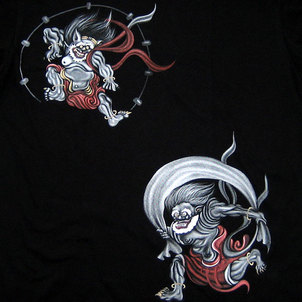 Raijin, the thunder god and Fujin, the wind god. Raijin, the thunder god and Fujin, the wind god. Last night was a howler. Fujin (“Foo-jeen”), the wind god, arrived in Himeji bearing both fragrance (plum blossom) and foulness (cedar pollen). I could almost hear the pollen drumming against my 100-year-old walls trying to get inside. I tried plugging the gaps in the warped timber, the cracks in the mud walls and the chinks in the tatami mats, but I can tell you I've failed; my wastepaper basket overflows with soggy tissues, my tears sprinkle this keyboard and I need a bottle brush to de-itch my throat. It’s not Fujin’s fault. The big green dude with the crazy hairdo is in town because it's that time of year again. From March to April, he dips in his finger and gives the atmosphere a good stir over Japan. Fujin is one of the senior Yaoyorozu-no-Kami 八百万の神, (8 million gods) which ‘inhabit’ the Shinto world and the ‘spiritual' force behind the Haru-ichiban which heralds the start of spring. Like the ‘Freemantle Doctor’ of Western Australia, the Mistral in France and the Monsoon in south Asia, the Haru-ichiban signifies a turning point in the seasons and is the first strong wind to blow across the archipelago before the typhoons arrive in summer. The boffins tell it like this: low pressure systems pushing in from China create a vacuum into which air from the Pacific is sucked and this generates the big southerlies. They shake down the cedar plantations upcountry, delivering pollen up the nostrils of the good and innocent, knotting my saliva, tickling my throat and causing my eyes to spring leaks. I cycle to work crying. Sidenote: Why so much cedar pollen? My good friend Smokin Joe Matsumoto, the old kitchen gardener who lives up the street, explains: “After the war, Japan rebuilt with timber. Towns and villages went on cedar growing rampages backed by government tax concessions. These plantations have matured. So have their planters. Now, no young people want to manage these forests. They don't like the snakes, boars, hornets and bears (ed: and poor iPhone reception). Cheap imports from China and Siberia have sealed the timber industry’s fate.” Enough of timber. Let's get back to winds, which are not just ‘winds’ in Japan. Each has its own handle, character and purpose. They're named for their strength (typhoon), taste and smell (shiokaze, sea wind), cooling effects (soyokaze, summer breeze), location (yamakaze , mountain wind,) and ‘divine' purposes (kamikaze). My neighborhood is shielded by the mountains in the north and the island of Shikoku in the south. Unlike the rest of urban Japan, the traditional neighborhood in which I have lived for 15 years, is not a sophisticated place. Wind strength is measured by a wetted finger, or a loose sheet of roofing iron on an abandoned house nearby which flutters in the dry Siberian winter winds, clangs in the late summer typhoons and bangs in early spring when the Haru-ichiban arrives. Spring has sprung and I don't need Fujin to tell me. The Semba River which flows through my neighborhood is running fast and clear, the cherry blossom buds overhanging the castle moat are groaning under pressure. Bulbuls wake me up at sunrise with their sing-song calls, raiding the gardens of the abandoned houses for loquat flower nectar, and the sickly sweet fragrance of jin-chou-ge (daphne) is everywhere.  Fujin. Fujin. The Haru-ichiban is Japan’s proverbial ‘wind of change’. It heralds the start of everything new; kids march back to school in stiff new uniforms, university undergraduates dye their hair brown and gold. Graduates, on the other hand, revert to black before joining the grey workaday battalions. And Ching! go the tills of Himeji’s hairdressers. Which reminds me, my sideburns need pruning. Next week: The Good Hood breaks out bento and sake bottle and heads for hanami (cherry blossom viewing).
0 Comments
|
This Blog:What is the essence of a traditional Japanese neighbourhood? Writing from my home in Himeji, a castle town in western Honshu, Seaweed Salad Days distills, ferments, presents! Archives
March 2024
Categories
All
|

 RSS Feed
RSS Feed
